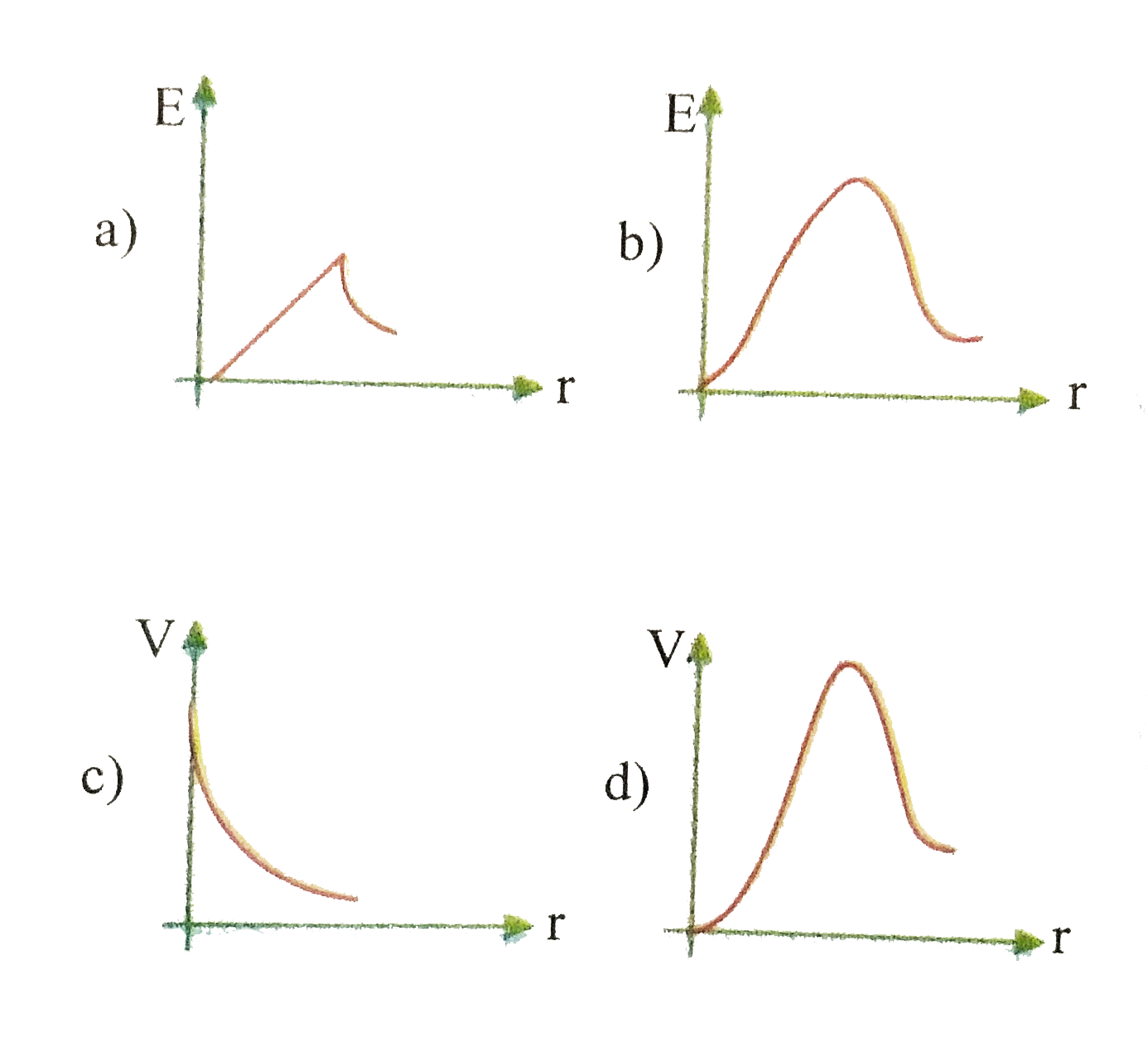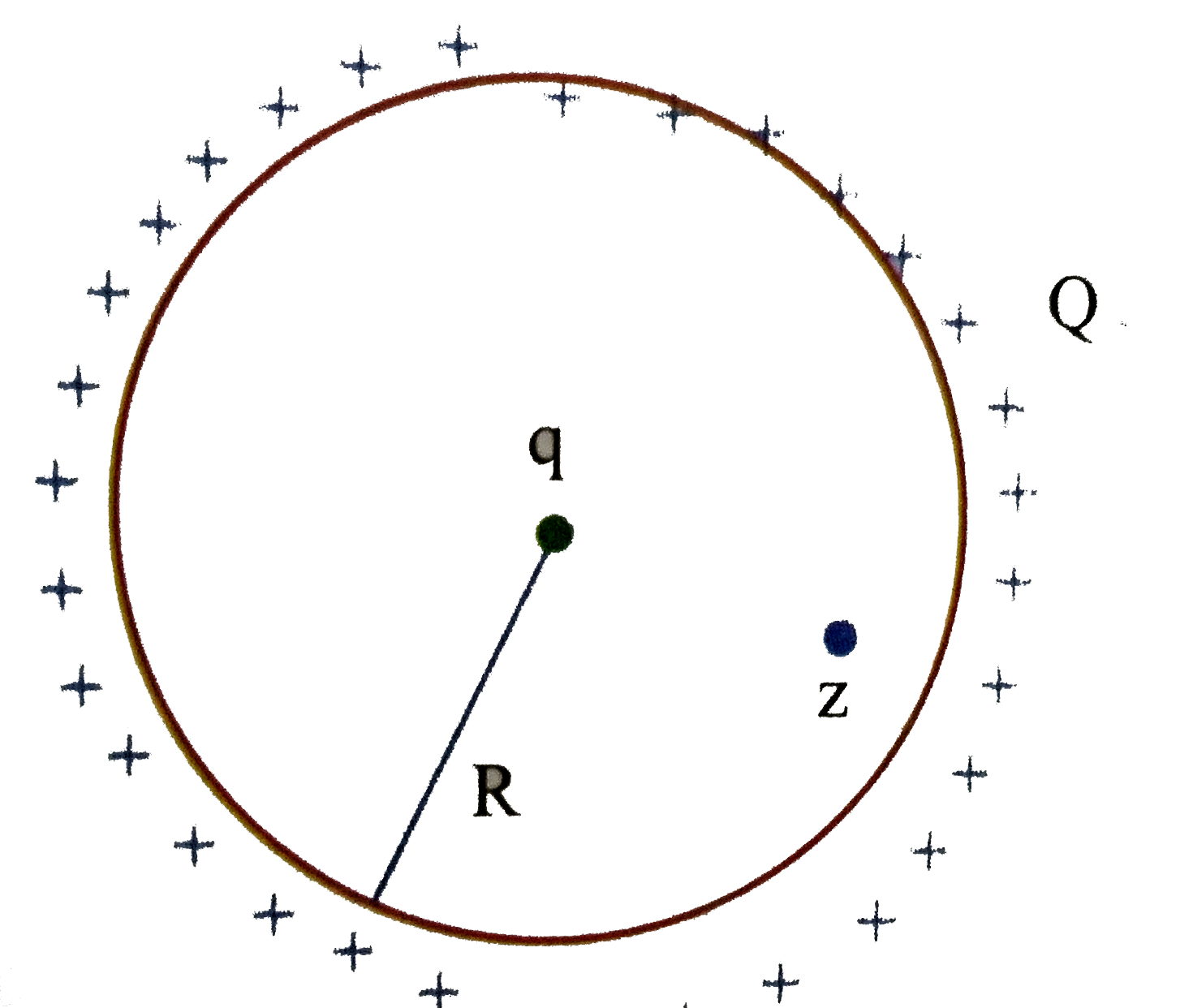A ring of radius R carries a uniformly distributed charge +Q. A point charge −q is placed on the axis of the ring at a distance 2R from the centre of the ring and released from rest. The particle executes a simple harmonic motion along the axis of the ring. State True or False.
To determine whether the statement is true or false, we will analyze the situation step by step.
Step 1: Understand the System
We have a ring of radius R with a uniformly distributed positive charge +Q. A negative point charge −q is placed on the axis of the ring at a distance 2R from the center of the ring.
Hint: Visualize the setup: a charged ring and a point charge along its axis.
Step 2: Determine the Electric Field
The electric field E at a point along the axis of the ring due to the ring's charge can be calculated using the formula:
E=kQx(R2+x2)3/2
where k is Coulomb's constant, Q is the charge on the ring, R is the radius of the ring, and x is the distance from the center of the ring along the axis.
Here, x=2R.
Hint: Remember that the electric field direction is away from positive charges and towards negative charges.
Step 3: Calculate the Force on the Point Charge
Since the point charge −q is negative, the force F acting on it due to the electric field will be in the opposite direction to the electric field:
F=−qE
Hint: The force on a negative charge is opposite to the direction of the electric field.
Step 4: Analyze Motion
When the charge −q is released, it will experience a force that will cause it to accelerate towards the ring. As it moves towards the ring, it will gain speed. When it reaches the center of the ring, it will have maximum speed.
Hint: Consider how forces affect motion: acceleration leads to changes in velocity.
Step 5: Oscillation
Once the charge passes the center of the ring, it will continue moving due to inertia. However, as it moves away from the center, the electric field will exert a force on it, pulling it back towards the center. This process will repeat, causing the charge to oscillate back and forth along the axis of the ring.
Hint: Think about how a pendulum or spring oscillates back and forth due to restoring forces.
Step 6: Simple Harmonic Motion
The motion of the charge can be described as simple harmonic motion (SHM) because the restoring force acting on it is proportional to its displacement from the equilibrium position (the center of the ring).
Hint: Recall the characteristics of SHM: the force is proportional to the displacement and directed towards the equilibrium position.
Conclusion
Since the charge −q indeed executes simple harmonic motion along the axis of the ring, we conclude that the statement is True.
Final Answer: True
We have a ring of radius R with a uniformly distributed positive charge +Q. A negative point charge −q is placed on the axis of the ring at a distance 2R from the center of the ring.
The electric field E at a point along the axis of the ring due to the ring's charge can be calculated using the formula:
E=kQx(R2+x2)3/2
where k is Coulomb's constant, Q is the charge on the ring, R is the radius of the ring, and x is the distance from the center of the ring along the axis.
Since the point charge −q is negative, the force F acting on it due to the electric field will be in the opposite direction to the electric field:
F=−qE
When the charge −q is released, it will experience a force that will cause it to accelerate towards the ring. As it moves towards the ring, it will gain speed. When it reaches the center of the ring, it will have maximum speed.
Once the charge passes the center of the ring, it will continue moving due to inertia. However, as it moves away from the center, the electric field will exert a force on it, pulling it back towards the center. This process will repeat, causing the charge to oscillate back and forth along the axis of the ring.
The motion of the charge can be described as simple harmonic motion (SHM) because the restoring force acting on it is proportional to its displacement from the equilibrium position (the center of the ring).
Since the charge −q indeed executes simple harmonic motion along the axis of the ring, we conclude that the statement is True.
Topper's Solved these Questions
- MISCELLANEOUS VOLUME 3BOOK - CENGAGE PHYSICS ENGLISHCHAPTER - MISCELLANEOUS VOLUME 3EXERCISE - Assertion-Reasoning Type
1 Video
- MISCELLANEOUS VOLUME 3BOOK - CENGAGE PHYSICS ENGLISHCHAPTER - MISCELLANEOUS VOLUME 3EXERCISE - Multiple correct Answer type
109 Videos
- MISCELLANEOUS VOLUME 3BOOK - CENGAGE PHYSICS ENGLISHCHAPTER - MISCELLANEOUS VOLUME 3EXERCISE - Fill in the blanks
10 Videos
- MAGNETIC FIELD AND MAGNETIC FORCESBOOK - CENGAGE PHYSICS ENGLISHCHAPTER - MAGNETIC FIELD AND MAGNETIC FORCESEXERCISE - Multiple Correct Answer type
2 Videos
- MISCELLANEOUS VOLUME 5BOOK - CENGAGE PHYSICS ENGLISHCHAPTER - MISCELLANEOUS VOLUME 5EXERCISE - Integer
12 Videos
Similar Questions
Electric charge Q is uniformly distributed around a thin ring of radius a. find the potential a point P on the axis of the ring at a distance x from the centre of the ring .

View SolutionA non conducting ring of radius R has uniformly distributed positive chargeq. A small particle of mass m and charge −q is placed on the axis of the ring at point P and released If R>>x. The particle will undergo oscillations along the axis of symmerty with an angular frequency that is equal to

View SolutionA ring of radius a contains a charge q distributed. uniformly ober its length. Find the electric field at a point. on the axis of the ring at a distance x from the centre.
View SolutionA circular ring carries a uniformly distributed positive charge .The electric field(E) and potential (V) varies with distance (r ) from the centre of thr ring along its axis as

View SolutionA circular ring of mass M and radius 'a' is placed in a gravity free space. A small particle of mass m placed on the axis of the ring at a distance √3a from the center of the ring, is released from rest. The velocity with which the particle passes through the center of the ring is
View SolutionA charge of 5 nC is uniformly distributed on a ring of radius 4 cm. Find the potential at the axis at a distance of 3 cm from the center.
View SolutionA thin circular wire of radius r has a charge Q. If a point charge q is placed at the centre of the ring, then find the increase in tension in the wire.
View SolutionElectric charge Q is uniformly distributed around a thin ring of radius a. find the potential a point P on the axis of the ring at a distance x from the centre of the ring .

View SolutionA positive charge Q is uniformly distributed along a circular ring of radius R.a small test charge q is placed at the centre of the ring.

View SolutionA positive charge Q is uniformly distributed along a circular ring of radius R.a small test charge q is placed at the centre of the ring .The

View Solution